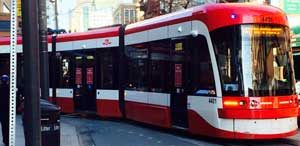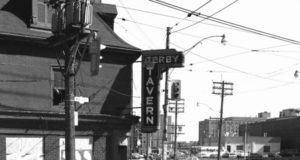Eric Morse –
In the last week of May, Waterfront Toronto, the City and the TTC conducted public consultations on Stage One of a ‘Waterfront Transit Reset’ project slated to go to Executive Committee and Council in June. At that time Council will decide whether there should indeed be a Stage Two and what form it should take.
According to presenters, the study involves a top-down review of “existing transit to previously planned waterfront initiatives, and current and future transit needs”. As such, the presentation to the public forum was remarkably diffuse, involving four options for each of four sectors from Long Branch to Woodbine. The study aims at an integrated waterfront transit solution to be coordinated with existing proposals for urban transit including Smart Track, the Downtown Relief Line, Scarborough Transit Planning and the Metrolinx Regional Express Rail programme. It also aims at creating and/or strengthening north-south links across the railroad barrier that exists from the west end to the Don River.
From a Downtown perspective the major issues that seemed to emerge were how streetcar/subway links could be handled in the highly congested area between Spadina and Parliament. The Union Station loop is at capacity, and a Bremner Boulevard loop is in consideration.
Three waterfront Councillors (Pan McConnell, Ward 28, Mike Layton, Ward 19 and Joe Cressy, Ward 20) and one MP (Adam Vaughan, Spadina-Fort York) turned out for the May 25 forum.
“Tonight was a first stage in looking at a reset of public transportation,” Ward 28 Councillor Pam McConnell said in an interview with the Bulletin.. “We’re getting to the end of Stage One, it will be presented to Executive and Council in June. That report will recommend the other options that should be studied in the second round. Tonight was really a basket of options that could be utilized in Stage Two, if Council does decide that there should be a Stage Two.”
Some community representatives were critical of the diffuseness of the presentation, and it was noticeable that fewer than half of the audience returned for the post-workshop summation. Corktown BRA Board member Larry Webb told the Bulletin that although he is normally very satisfied with the way the public consultation process works, he was not comfortable with the evening’s proceedings. “They are having two public consultations in two nights, and then on-line public input closes on Friday (June 3). Given the number of options that were put on the table tonight, this has more the feel of ‘checking the procedural boxes’ before they have to go to Council.”
In conversation with the Bulletin, long-time transit commentator Steve Munro expressed serious concern with the presentation’s quality. “They seem to be putting things back on the table that were taken off it years ago…as for the Union Station streetcar loop, there have been estimates as to what it would take to make that serviceable for more traffic, one figure comes in at $250 million. But how many times can you dig up Bay Street?”
Other views expressed were that the new Cherry St. streetcar line and its future extensions must be tied into the existing transit system either via Parliament or Cherry Streets. Either will require tunnelling under the railroad right-of-way. In conversation, Councillor Mike Layton also noted that some form of tunnel connection from Liberty Village to transit lines south of the railroad would be highly desirable.
Public consultations had closed at press time. For further information visit www.waterfronttoronto.ca/explore_projects2/the_wider_waterfront/waterfront_transit_reset
 TheBulletin.ca Journal of Downtown Toronto
TheBulletin.ca Journal of Downtown Toronto


